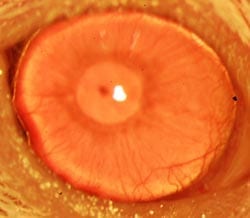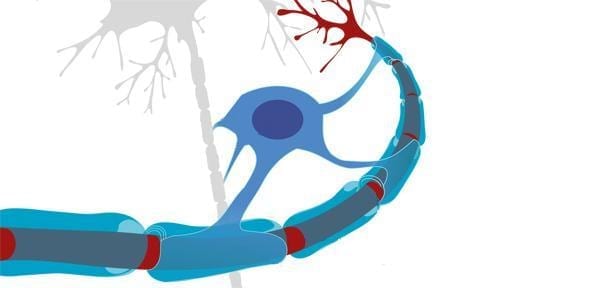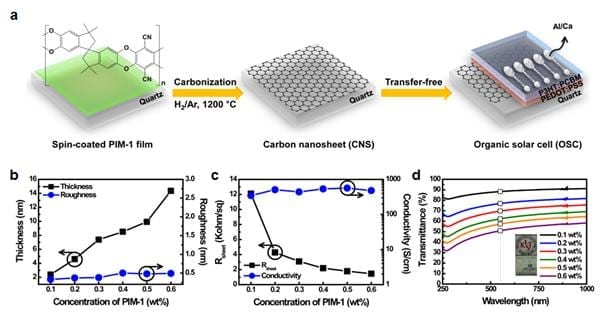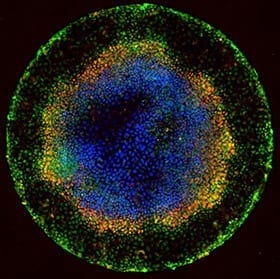
Limbal stem cells — identified with a new marker — could reverse a leading cause of blindness
Boston researchers have identified a way to enhance regrowth of human corneal tissue to restore vision, using a molecule known as ABCB5 that acts as a marker for hard-to-find limbal stem cells. This work, a collaboration between the Massachusetts Eye and Ear/Schepens Eye Research Institute (Mass. Eye and Ear), Boston Children’s Hospital, Brigham and Women’s Hospital and the VA Boston Healthcare System, provides promise to burn victims, victims of chemical injury and others with damaging eye diseases. The research, published this week in Nature, is also one of the first known examples of constructing a tissue from an adult-derived human stem cell.
Limbal stem cells reside in the eye’s basal limbal epithelium, or limbus, and help maintain and regenerate corneal tissue. Their loss due to injury or disease is one of the leading causes of blindness. In the past, tissue or cell transplants have been used to help the cornea regenerate, but it was unknown whether there were actual limbal stem cells in the grafts, or how many, and the outcomes were not consistent.
In this study, researchers were able to use antibodies detecting ABCB5 to zero in on the stem cells in tissue from deceased human donors and use them to regrow anatomically correct, fully functional human corneas in mice.
Read more . . .
The Latest on: Regrow Human Corneas
[google_news title=”” keyword=”Regrow Human Corneas” num_posts=”10″ blurb_length=”0″ show_thumb=”left”]
via Google News
The Latest on: Regrow Human Corneas
- New treatment could reverse hair loss caused by an autoimmune skin diseaseon May 9, 2024 at 1:21 pm
Researchers developed a potential new treatment for alopecia areata, an autoimmune disorder that causes hair loss. The microneedle patch delivers immune-regulating molecules that can teach T cells not ...
- Scarce organ donations strain life-saving resourceson May 8, 2024 at 4:08 pm
Pham Thi Su held an organ donation commitment form in her trembling hands.
- Dehydrated Blood, Corneal Implants, And 35 Other Wild Photos Of The Human Body That Prove Science Is Basically Magicon May 5, 2024 at 1:16 pm
3.Here's what a biker's legs look like after completing just one stage of the Tour de France: 4.And this is what an Olympic rower's hands look like after rowing for 1,000 km: ...
- Human Spectacleon April 26, 2024 at 5:00 pm
For more audio journalism and storytelling, download New York Times Audio, a new iOS app available for news subscribers. By New York Times Audio Gladiators in the Colosseum. Sideshow performers ...
- Teaching for Tomorrow’s Employment Landscapeon April 17, 2024 at 5:00 pm
As for the engineering majors, their focus was on biomedical engineering, including techniques such as tissue engineering and organ regeneration to replace or regenerate human cells, tissues or organs ...
- UM research discovers new way to generate human cartilageon April 14, 2024 at 7:00 am
Grimes said there is a critical unmet need for new methods to regenerate human cartilage for the 230,000 children born annually in the U.S. with craniofacial defects. Growing cartilage in the ...
- Research team discovers new way to generate human cartilageon April 9, 2024 at 5:00 pm
Grimes said there is a critical unmet need for new methods to regenerate human cartilage for the 230,000 children born annually in the U.S. with craniofacial defects. Growing cartilage in the ...
- New way to generate human cartilageon April 9, 2024 at 5:00 pm
Grimes said there is a critical unmet need for new methods to regenerate human cartilage for the 230,000 children born annually in the U.S. with craniofacial defects. Growing cartilage in the ...
- Surgeons Perform World's First Whole Eyeball Transplant on Arkansas Veteranon November 10, 2023 at 11:42 am
Corneal transplants ... had ever attempted a human eyeball transplant before. One of the main hurdles is getting the optic nerve, which links the eye to the brain, to regenerate completely.
- Regrow Agon July 19, 2023 at 5:45 am
Here, two panels of innovators share their approaches to filling in systemic gaps in our food system. 6 months ago - By partnering with Regrow Ag to track and reduce supply chain emissions, Kellogg's ...
via Bing News










